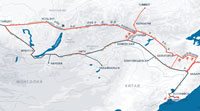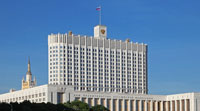Landmark transactions of 2014

Russian Railways conducts assessments of the market environment on a regular basis, which makes it possible to choose the best time and tools to conclude transactions on the Russian and international capital markets. The borrowing requirements of Russian Railways are largely determined by the investment costs of the Company’s projects that are financed using borrowed funds.
International capital markets
Russian Railways placed it’s second Eur-denominated Eurobonds in the first quarter of 2014.
The order book closed on 27 February and funds were received on 6 March. The placement was for EUR 500 mln with a coupon rate of 4.6% p.a. and maturity in nine years.
On the back at four-day road show in Europe’s key financial centres — Germany (Munich), Switzerland (Zurich) and the UK (London) Rusian Railways announced its benchmark offering.
The Joint leed managers the placement and Russian Railways management conducted regular monitoring of the market environment in February to find the optimal window given the high level of volatility seen over the course of the month. Improvements in the market were seen in late February and the Company decided to open the order book after taking into account the overall downward trend in the economy and the growing geopolitical instability.
The final order book showed great variation with tickets from more than 130 top tier accounts from, (18%) Germany and Austria, (14%) from Switzerland, 56% from other countries of continental Europe, including Russia, and 9% from the UK.
This transaction was the last market placement by Russian corporations prior to the virtual closing of markets and the longest tenor achieved among by quasi-sovereign issuers from Russia in 2014.
Russian capital market
Infrastructure bonds were placed in 2014 for a total of RUB 50 bln
Russian Railways continued implementing the infrastructure bonds programme approved by the Russian Government in 2013.
CPI — linked extra long term infrastrucrure bonds, which Russian Railways placed initially in 2013, are a fundamentally new financial product on the domestic market. It is designed for long-term investors and pension funds who are interested in diversifying their portfolio top-rated bonds that ensure protection inflation.
In June and October 2014, Russian Railways placed its seventh and eighth tranches of infrastructure bonds for a total of RUB 25 bln each with maturities 25 and 30 years, respectively. As was the case in 2013, the infrastructure bonds were purchased in 2014 by Vnesheconombank, which is the authorised manager of the Russian Pension Fund. Thus, the total amount of outstanding infrastructure bonds increased to RUB 200 bln as of the end of 2014.
Russian Railways spends the proceeds received from the infrastructure bond placement on the implementation of investment projects with payback periods of 15 to 30 years, including for the purchase of new locomotives, an increase in the network’s througout capacity on a number of routes as well as the partial funding of projects to upgrade the Baikal-Amur and Trans-Siberian Mainlines.
The National Wealth Fund has been identified as a new key source of funding for the Russian Railways investment programme in 2015. The Company plans to receive these funds both in the form of debt capital CPI — linked extra long term infrastrucrure bonds and share capital — preferred shares. In December 2014, Russian Railways projects amounted to RUB 100 bln were approved by a resolution of the Russian Government to be funded using the National Wealth Fund. The Company expects to receive the funds in 2015.









